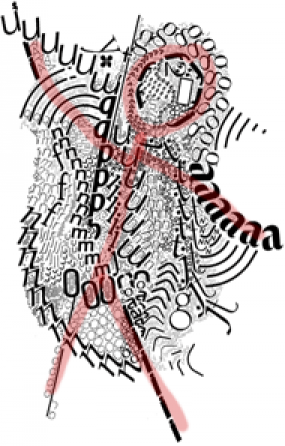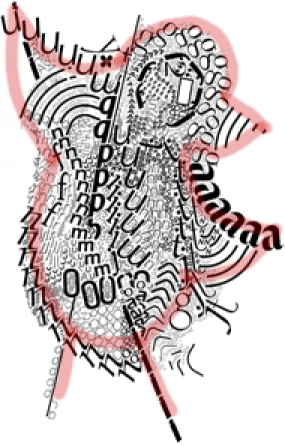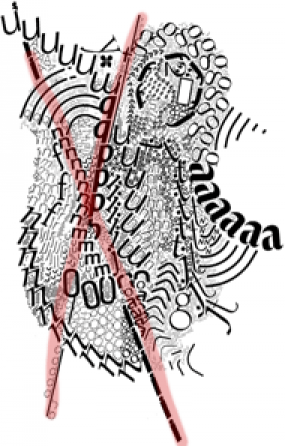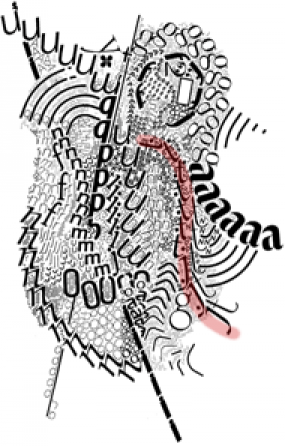Let’s begin with the title: this half is for the ceremony—firstly, this suggests a splitting of the poem to produce a second half, another form that matches this poem in some way, a second stanza so to speak. This also raises the question as to what the other half is like—does it reflect the non-semantic nature of this poem, or is it language that is semantically clear? Is this also a reference to a distinction between types of ceremonies, or between the ritual moment and daily life? And what is the thisthat is being referenced, the figure or the language? Thus, the title makes the poem ambiguous from the very start. The focus on |
|
| Turning to what appears to be the literal, yet ambiguous “body” of the poem, let’s reflect on the imagistic elements. The poem appears to be a figure with a head and legs (Figure 1). It may also have a beak off to the right, which would suggest religious bird iconography, like doves perhaps, which also explains the wide arms or wings extending from its sides (Figure 2). This figure, while ambiguous, appears animate, with a dramatic posture, seemingly almost off-balance and looking and maybe moving towards the right-hand margin. | |
| Examining in more detail the letters that make up the figure, we can see numerous repetitions as well as subtle alterations—such as between q and p, n and m, t and j, e and c—which fill in and texture the image but also keep us from fixating on a single letter for too long. There is also a notable contrast between bolded, regular, and italicized fonts, between font sizes, and between serif and sans-serif typefaces. These contrasts produce a rich visual texture as well as highlight features of the figure. For instance, the bold “a”s on the right hand side give the sense of an arm, while the bold “n”s on the lower left-hand edge outline the belly or rump. These textural features continue around the head with the soft “g”s, and so on. These repeated letters mimic a feature of ceremonies—the repeated forms of language and actions—and the form of the figure, perhaps hinting at a complex, interwoven relation between ceremonial figures and their language use. | |
| Another series of letters that inform this figure are the intersecting lines (Figure 3) that cross through the belly or rump of the figure, making up the legs and extending into one arm and, more bafflingly and conspicuously, up past the head. These intersecting lines, made up of “l”s and “i”s, contribute to our reading of the figure in two ways. Firstly, they both help construct the figure by suggesting arms and legs, as well as disrupt the imagery by cutting it in half, twice. Furthermore, they become incorporated into the figure where they intersect, rupturing at the middle of the alphabet (l, m, n, o, p) which dissolves and incorporates them into the figure. Secondly, these intersecting lines produce a cross (from an off-center perspective from above or below). This subtly incorporated iconic image of Christianity affirms the notion of ritual and ceremony from the title. Interestingly, the figure also seems to only be partially connected to this cross and seems to be kinetically moving away to the right, perhaps even flinging its legs made of the lines of “j”s and brackets (Figure 4), suggesting movement off—rather than stasis on—the cross. | |
A Few More AlternativesOf course, there are a number of other quite plausible interpretative possibilities. For instance, it may also be a loosely robed, hooded figure falling off of stilts (thereby invoking perhaps an opening ceremony at a circus). At the same time, the focus on repetition of letters suggests poetic and ritualistic sensibilities that tie less strongly to the circus domain than the religious one noted here (although the poem is certainly playing around with language, which could connect to the playful qualities of the circus as well). Without the title, the iconic features of a dove and a cross would likely not become salient and the poem would be much more ambiguous. Keeping the title in mind, in this case, helps direct interpretations of the form, but does not prohibit other connections. A circus reading may still be viable. At the same time, this work can be treated more abstractly as well, with a more focused discussion of the patterns of relation and transformation that move throughout its textured figure. Here the patterns of ritualistic language (themselves full of poetic conventions) mentioned above, opens up a more abstract understanding of language use. For instance, one might consider a distinction between a part of language used for ritual and one used for daily life. But are such distinctions tenable? Furthermore, how do these relate to the visualized distinctions between semantic and non-semantic representations in this poem? This poem suggests many avenues for further exploration and interpretation. Finally, of course, reading it might be seen as a “ceremony” in itself, with the close focus and meditation on visual forms that is practiced in cultural ceremonies, such as the production of and meditation on Navajo sand painting or Buddhist mandalas. Here the analytical process focuses the attention and then encourages the imagination to expand, a process that is pleasurable and also, perhaps, sacred. |
Works Cited
- beaulieu, derek.
this half is for the ceremony.
Canadian Literature 195 (2007): 66. Print. (Link)













 ©
©